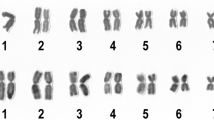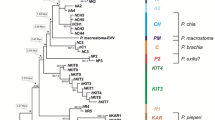Abstract
The Simulium rufibasis subgroup is one of three subgroups of the Simulium (Simulium) tuberosum species-group; it is characterized by a pair of clustered stout hairs on the ventral surface of female abdominal segment 7. A member of the S. rufibasis subgroup in Taiwan was investigated morphologically and genetically using the universal cytochrome c oxidase subunit I (COI) barcoding gene and polytene chromosomal banding pattern. The Taiwanese material is morphologically similar to S. rosliramlii Takaoka & Chen from Vietnam and represents the second species of the S. rufibasis subgroup known from Taiwan. It also represents a novel molecular lineage that is distinct from three other primary lineages identified as S. doipuiense, S. doipuiense/S. rufibasis, and S. weji previously reported from Thailand. The mitochondrial evidence for a distinct lineage in Taiwan is supported by chromosomal analysis, which revealed unique sex chromosomes. For nomenclatural stability, we associate the name S. arisanum Shiraki with the Taiwanese entity. Originally described from females from Taiwan, S. arisanum until now has remained an enigmatic species.


Similar content being viewed by others
References
Adler PH, Crosskey RW (2018) World blackflies (Diptera: Simuliidae): a comprehensive revision of the taxonomic and geographical inventory [2018]. Available: https://biomia.sites.clemson.edu/pdfs/blackflyinventory.pdf. Accessed 8 April 2018
Adler PH, Huang YT, Reeves WK, Kim SK, Otsuka Y, Takaoka H (2013) Macrogenomic evidence for the origin of the black fly Simulium suzukii (Diptera: Simuliidae) on Okinawa Island, Japan. PLoS One 8:e70765
Adler PH, Takaoka H, Sofian-Azirun M, Low VL, Ya’cob Z, Chen CD, Lau KW, Pham XD (2016) Vietnam, a hotspot for chromosomal diversity and cryptic species in black flies (Diptera: Simulidae). PLoS One 11:e0163881
Choochote W, Takaoka H, Fukuda M, Otsuka Y, Aoki C, Eshima N (2005) Seasonal abundance and daily flying activity of black flies (Diptera: Simuliidae) attracted to human baits in Doi Inthanon National Park, northern Thailand. Med Entomol Zool 56:335–348
Crainey JL, Wilson MD, Post RJ (2010) Phylogenetically distinct Wolbachia gene and pseudogene sequences obtained from the African onchocerciasis vector Simulium squamosum. Int J Parasitol 40:569–578
Dhiman S, Hazarika S, Rabha B, Das NG, Bhola RK, Veer V, Singh L (2014) Black fly (Simulium sp) composition, daytime biting activity and possible onchocerciasis infection in north-east, India. J Environ Biol 35:421–425
Folmer O, Black M, Hoeh W, Lutz R, Vrijenhoek R (1994) DNA primers for amplification of mitochondrial cytochrome c oxidase subunit I from diverse metazoan invertebrates. Mol Mar Biol Biotechnol 3:294–299
Fukuda M, Takaoka H, Uni S, Bain O (2008) Infective larvae of five Onchocerca species from experimentally infected Simulium species in an area of zoonotic onchocerciasis in Japan. Parasite 15:111–119
Guindon S, Dufayard JF, Lefort V, Anisimova M, Hordijk W, Gascuel O (2010) New algorithms and methods to estimate maximum-likelihood phylogenies: assessing the performance of PhyML 3.0. Syst Biol 59:307–321
Hurst GD, Jiggins FM (2005) Problems with mitochondrial DNA as a marker in population, phylogeographic and phylogenetic studies: the effects of inherited symbionts. Proc Biol Sci 272:1525–1534
Kumar S, Stecher G, Tamura K (2016) MEGA7: molecular evolutionary genetics analysis version 7.0 for bigger datasets. Mol Biol Evol 33:1870–1874
Low VL, Takaoka H, Adler PH, Ya’cob Z, Norma-Rashid Y, Chen CD, Sofian-Azirun M (2015a) A multi-locus approach resolves the phylogenetic relationships of the Simulium asakoae and Simulium ceylonicum species groups (Diptera: Simuliidae) in Malaysia: evidence for distinct evolutionary lineages. Med Vet Entomol 29:330–337
Low VL, Tay ST, Kho KL, Koh FX, Tan TK, Lim YAL, Panchadcharam C, Ong BL, Norma-Rashid Y, Sofian-Azirun M (2015b) Molecular characterisation of the tick Rhipicephalus microplus in Malaysia: new insights into the cryptic diversity and distinct genetic assemblages throughout the world. Parasit Vectors 8:341
Low VL, Takaoka H, Pramual P, Adler PH, Ya’cob Z, Huang YT, Pham XD, Ramli R, Chen CD, Wannaket A, Sofian-Azirun M (2016a) Delineating taxonomic boundaries in the largest species complex of black flies (Simuliidae) in the Oriental Region. Sci Rep 6:20346
Low VL, Norma-Rashid Y, Sofian-Azirun M (2016b) Playing hide-and-seek with the tiny dragonfly: DNA barcoding discriminates multiple lineages of Nannophya pygmaea in Asia. J Insect Conserv 20:339–343
Low VL, Takaoka H, Pramual P, Adler PH, Yacob Z, Chen CD, Yotopranoto S, Zaid A, Hadi UK, Lardizabal ML, Nasruddin-Roshidi A, Sofian-Azirun M (2016c) Three taxa in one: cryptic diversity in the black fly Simulium nobile (Diptera: Simuliidae) in Southeast Asia. J Med Entomol 53:972–976
Low VL, Tan TK, Prakash BK, Vinnie-Siow WY, Tay ST, Masmeatathip R, Hadi UK, Lim YAL, Chen CD, Norma-Rashid Y, Sofian-Azirun M (2017) Contrasting evolutionary patterns between two haplogroups of Haematobia exigua (Diptera: Muscidae) from the mainland and islands of Southeast Asia. Sci Rep 7:5871
Pramual P, Adler PH (2014) DNA barcoding of tropical black flies (Diptera: Simuliidae) of Thailand. Mol Ecol Res 14:262–271
Pramual P, Thaijarern J, Wongpakam K (2016) DNA barcoding of human-biting black flies (Diptera: Simuliidae) in Thailand. Acta Trop 164:33–40
Puri IM (1932) Studies on Indian Simuliidae. Part II. Descriptions of males, females, and pupae of Simulium rufibasis Brunetti, its variety fasciatum nov. var. and of three new species from the Himalayas. Indian J Med Res 19:899–913
Shiraki T (1935) Simuliidae of the Japanese empire. Memoirs of the Faculty of Science and Agriculture, Taihoku Imperial University 16:1–90
Sriphirom P, Sopaladawan PN, Wongpakam K, Pramual P (2014) Molecular phylogeny of black flies of the Simulium tuberosum (Diptera: Simuliidae) species group in Thailand. Genome 57:47–55
Swofford DL (2002) PAUP* phylogenetic analysis using parsimony (*and other methods). Sinauer Associates, USA
Takaoka H (1977) Studies on blackflies of the Nansei Islands, Japan (Simuliidae; Diptera). III On six species of the subgenus Simulium Latreille Japanese. J San Zool 28:193–217
Takaoka H (1979) The black flies of Taiwan (Diptera: Simuliidae). Pac Insects 20:365–403
Takaoka H (2017) Speciation, faunal affinities and geographical dispersal of black flies (Diptera: Simuliidae) in the Oriental Region. Acta Trop 166:234–240
Takaoka H, Choochote W (2005) Two new species of Simulium (Simulium) (Diptera: Simuliidae) from northern Thailand. Med Entomol Zool 56:99–110
Takaoka H, Somboon P (2008) Eleven new species and one new record of black flies (Diptera: Simuliidae) from Bhutan. Med Entomol Zool 59:213–262
Takaoka H, Sofian-Azirun M, Ya’ cob Z, Chen CD, Lau KW, Low VL, Pham XD, Adler PH (2017) The black flies (Diptera: Simuliidae) of Vietnam. Zootaxa 4261:1–165
Tangkawanit U, Kuvangkadilok C, Baimai V, Adler PH (2009a) Morphotaxonomy of the Simulium (Simulium) tuberosum species group (Diptera: Simuliidae) in Thailand. Zootaxa 2048:31–46
Tangkawanit U, Kuvangkadilok C, Baimai V, Adler PH (2009b) Cytosystematics of the Simulium tuberosum group (Diptera: Simuliidae) in Thailand. Zool J Linnean Soc 155:289–315
Woodford L, Bianco G, Ivanova Y, Dale M, Elmer K, Rae F, Larcombe SD, Helm B, Ferguson HM, Baldini F (2018) Vector species-specific association between natural Wolbachia infections and avian malaria in black fly populations. Sci Rep 8:4188
Ya’cob Z, Takaoka H, Low VL, Sofian-Azirun M (2017a) First description of a new cryptic species, Simulium vanluni from Peninsular Malaysia: an integrated morpho-taxonomical and genetic approach for naming cryptic species in the family Simuliidae. Acta Trop 167:31–39
Ya’cob Z, Takaoka H, Low VL, Sofian-Azirun M (2017b) Uncovering the mask of the Simulium feuerborni complex (Diptera: Simuliidae): description of a new pseudocryptic species Simulium pairoti from Malaysia. Acta Trop 169:133–141
Funding
This work was supported by research grants from University of Malaya (RP021C-16SUS and RU005-201). For PHA, this is Technical Contribution of the Clemson University Experiment Station (6658) and is based on work supported in part by NIFA/USDA under project number SC-1700527.
Author information
Authors and Affiliations
Corresponding authors
Ethics declarations
Conflict of interest
The authors declare that they have no conflict of interest.
Additional information
Section Editor: Helge Kampen
Rights and permissions
About this article
Cite this article
Low, V.L., Takaoka, H., Adler, P.H. et al. A novel molecular and chromosomal lineage of the anthropophilic Simulium (Simulium) rufibasis subgroup (Diptera: Simuliidae) in Taiwan. Parasitol Res 117, 3137–3143 (2018). https://doi.org/10.1007/s00436-018-6011-7
Received:
Accepted:
Published:
Issue Date:
DOI: https://doi.org/10.1007/s00436-018-6011-7




